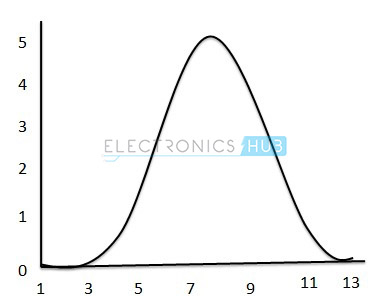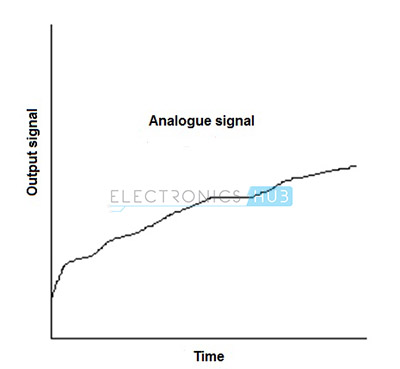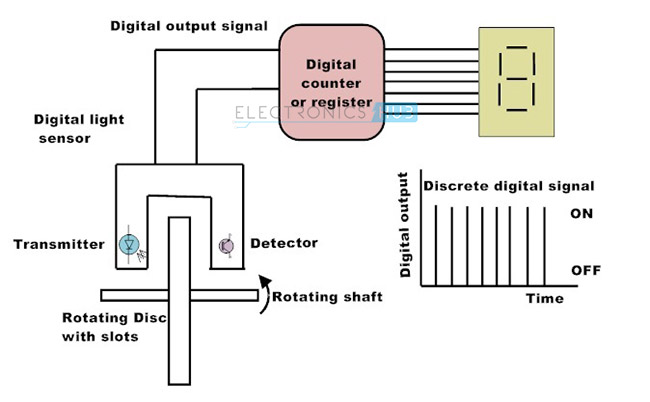We live in an Analog World with Digital means of communication and control Mechanical objects with Electrical signals. This is possible because of devices like sensors and transducers, which help us in converting data or information from one domain to other.
Introduction
Measurement is an important subsystem in any major system, whether it may be a mechanical system or an electronic system. A measurement system consists of sensors, actuators, transducers and signal processing devices. The use of these elements and devices is not limited to measuring systems. These are also used in the systems which perform specific tasks, to communicate with the real world. The communication can be anything like reading the status of a signal from a switch or to trigger a particular output to light up an LED. BACK TO TOP
Sensor and Transducer Definitions
The words sensors and transducers are widely used in association with measurement systems. The sensor is an element that produces signals relating to the quantity that is being measured. According to Instrument Society of America, “a sensor is a device that provides usable output in response to a specified quantity which is measured.” The word sensor is derived from the original meaning ‘to perceive.’ In simple terms, a sensor is a device that detects changes and events in a physical stimulus and provides a corresponding output signal that can be measured and/or recorded. Here, the output signal can be any measurable signal and is generally an electrical quantity. Sensors are devices that perform input function in a system as they ‘sense’ the changes in a quantity. The best example of a sensor is mercury thermometer. Here the quantity that is being measured is heat or temperature. The measured temperature is converted to a readable value on the calibrated glass tube, based on the expansion and contraction of liquid mercury. Actuators are devices that work opposite to sensors. A sensor converts a physical event into an electrical signal, whereas an actuator converts electrical signal into a physical event. When sensors are used at input of a system, actuators are used to perform output function in a system as they control an external device. Transducers are the devices that convert energy in one form into another form. Generally the energy is in the form of a signal. Transducer is a term collectively used for both sensors and actuators. BACK TO TOP
Criteria to Choose a Sensor
The following are certain features that are considered when choosing a sensor. BACK TO TOP
Basic Requirements of a Sensor or Transducer
The basic requirements of a sensor are: BACK TO TOP
Classification of Sensors
The scheme of classifying sensors can range from very simple to very complex. The stimulus that is being sensed is an important factor in this classification. Some of the stimuli are The sensors’ conversion phenomenon is also an important factor in classification of sensors. Some of the conversion phenomena are magneto electric, thermoelectric and photoelectric. Based on the applications of sensors, their classification can be made as follows. I. Displacement, Position and Proximity Sensors II. Temperature Sensors III. Light Sensors IV. Velocity and Motion V. Fluid Pressure VI. Liquid Flow and Level VII. IR Sensor VIII. Force IX. Touch Sensors X. UV Sensors All the sensors can be classified into two types based on the power or signal requirement. They are Active sensors and passive sensors. In order to operate active sensors, require power signal from an external source. This signal is called an excitation signal, and based on this excitation signal the sensor produces output. Strain gauge is an example of active sensor. It is a pressure sensitive resistive bridge network and doesn’t produce the output electrical signal on its own. The amount of force applied can be measured by relating it to the resistance of the network. The resistance can be measured by passing current through it. Current acts as the excitation signal. In contrast, passive sensors directly produce the output electrical signal in response to the input stimulus. All the power required by a passive sensor is obtained from the measurand. A thermocouple is a passive sensor. BACK TO TOP
Commonly used Sensors and Transducers
Some of the most commonly used sensors and transducers for different stimuli (the quantity to be measured) are BACK TO TOP
A Simple System using Transducers
A public addressing system is an example of a system using sensors and actuators.
It consists of a microphone, an amplifier and a loudspeaker. The sensor or the device with input function is a microphone. It senses the sound signals and transforms them into electrical signals. The amplifier receives these electrical signals and amplifies their strength. The actuator or the device with output function is loudspeaker. It receives the amplified electrical signals from the amplifier and converts them back into sound signals but with more reach. BACK TO TOP
Analogue Sensors
An analogue sensor produces continuously varying output signals over a range of values. Usually the output signal is voltage and this output signal is proportional to the measurand. The quantity that is being measured like speed, temperature, pressure, strain, etc. are all continuous in nature and hence they are analogue quantities. A Cadmium Sulfide Cell (CdS Cell) which is used to measure the intensity of light is an analogue sensor. The resistance of a CdS cell varies according to the intensity of the light incident on it. When connected to a voltage divider network, the change in resistance can be observed through varying output voltage. In this circuit, the output can vary from anywhere between 0 V to 5 V.
A thermocouple or a thermometer is an analog sensor. The following setup is used to measure the temperature of the liquid in the container using a thermocouple.
The output signal of the above setup can be depicted as follows:
The output of an analogue sensor tends to change smoothly and continuously over time. Hence the response time and accuracy of circuits employing analogue sensors is slow and less. In order to use these signals in a microcontroller based system, Analog to Digital converters can be used. Analogue sensors generally require an external power supply and amplification of some form to produce appropriate output signals. Op Amps are very useful in providing amplification and filtering. BACK TO TOP
Digital Sensors
A digital sensor produces discrete digital signals. The output of a digital sensor has only two states, namely ‘ON’ and ‘OFF’. ON is logic 1 and OFF is logic 0. A push button switch is the best example of a digital sensor. In this case, the switch has only two possible states: either it is ON when pushed or it is OFF when released or not pushed. The following setup uses a light sensor to measure the speed and produces a digital signal.
In the above setup, the rotating disc is connected to the shaft of a motor and has number of transparent slots. The light sensor captures the presence or absence of the light and sends logic 1 or logic 0 signal accordingly to the counter. The counter displays the speed of the disc. The accuracy can be increased by increasing the transparent slots on the disc as it allows more counts over the same amount of time. In general, the accuracy of a digital sensor is high when compared to an analogue sensor. The accuracy depends on the number of bits that are used to represent the measurand. Higher the number of bits, the greater is the accuracy. BACK TO TOP NEXT – POSITION SENSORS Comment * Name * Email * Website
Δ










![]()